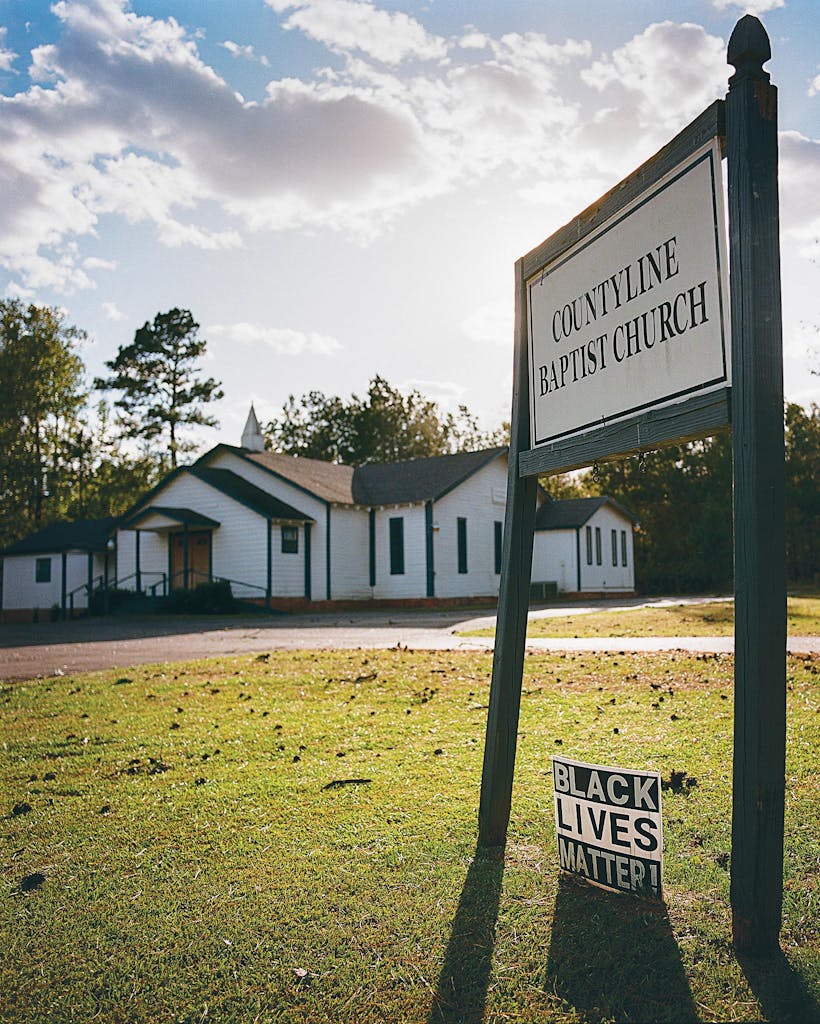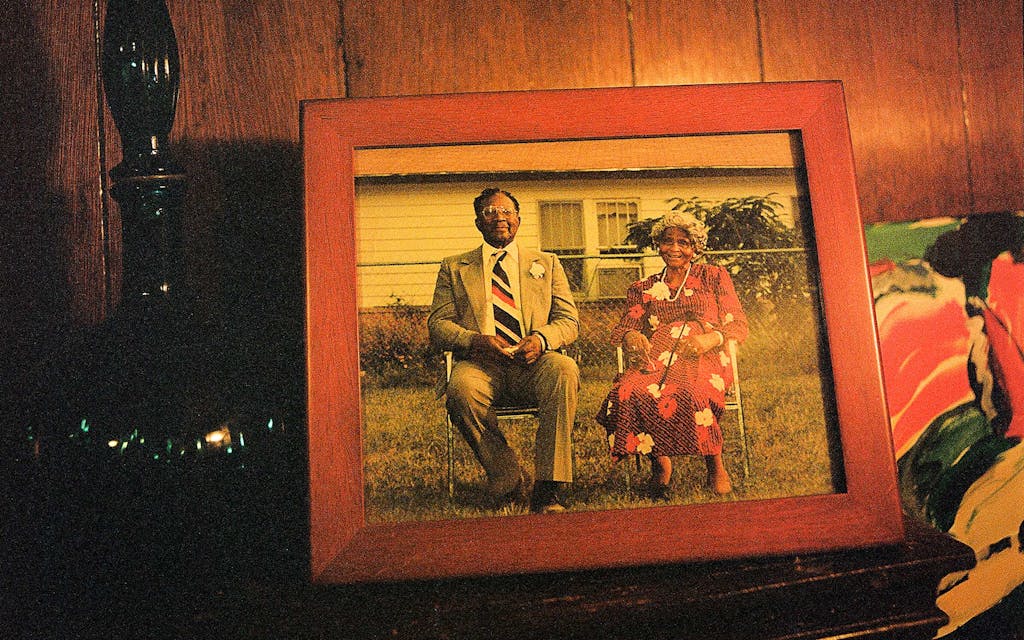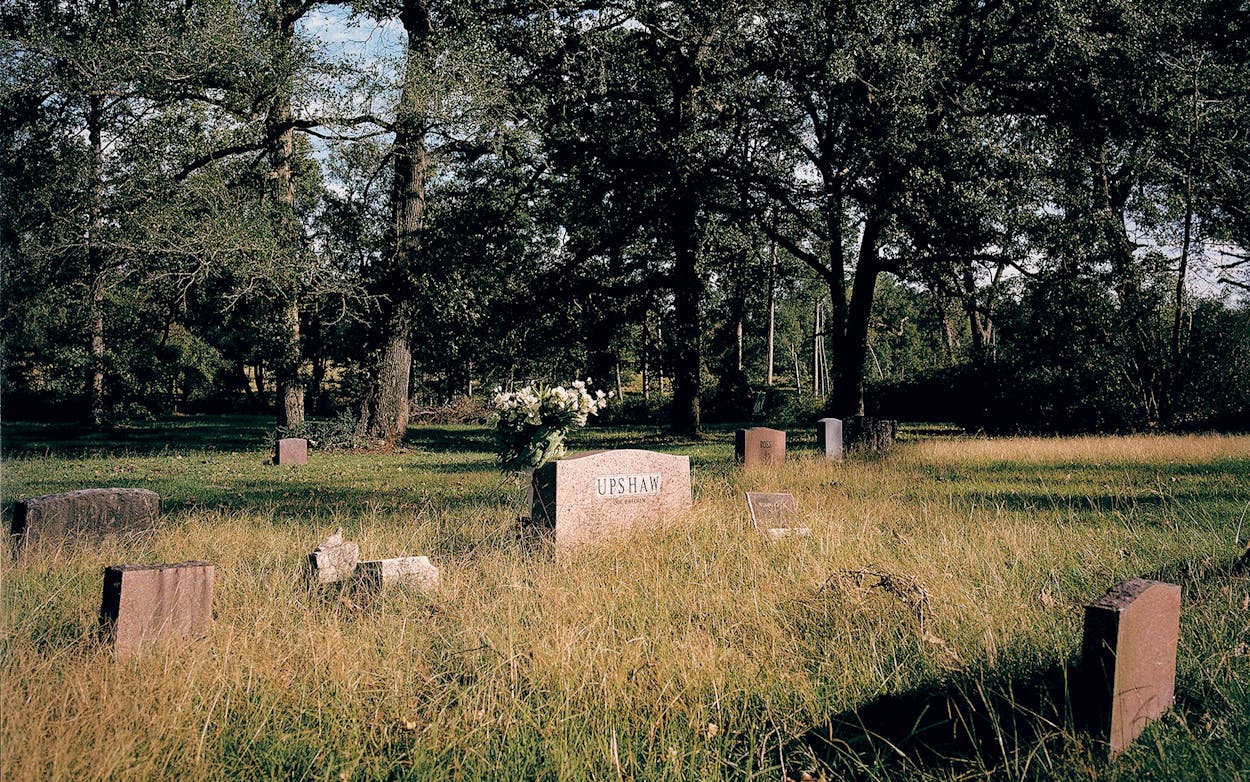To be an Upshaw is to remember where you came from. The Upshaw name carries with it more than a century of history—a beautiful, complicated inheritance rooted in a small East Texas town called County Line.
Occupying just one square mile of pine forest along the east bank of the Angelina River, which serves as the border between Nacogdoches and Cherokee counties, County Line is one of nearly six hundred historic settlements in Texas known as freedom colonies, all founded by formerly enslaved people. Upshaws have likely owned land in County Line since the 1870s, after news of the Emancipation Proclamation reached Texas. In the decades after their liberation, three brothers—Felix, Guss, and Jim Upshaw—owned land in the area, supporting themselves by farming, milling, and blacksmithing. They started families, and soon there were dozens of children, many grandchildren, and, eventually, hundreds of living descendants, some of whom live on the same land today.
Marilyn “Sister Girl” Upshaw, 66, and her sister Beatrice “Slang” Upshaw, 63, grew up in County Line. Sister Girl, who works as a sales associate at Etech, lives in a one-story house not far from the empty lot where her childhood home used to be. Demorris, her eldest sister, lives in a mobile home next door, and her older brother Eugene Upshaw, as well as Slang and her thirty-year-old daughter, Elia Upshaw Ali, live nearby.
I first visited the Upshaw clan in August 2019, on a sweaty summer day when their property was buzzing with activity. I’d joined photographer Richard Orton, a friend of the Upshaws for decades, who released a book of photos of the family in 2015. Orton and I had come for the family’s annual homecoming: Slang, Sister Girl, their siblings, and a host of other relatives and community members had gathered for a fish fry, a barbecue, and a revival. First, second, and third cousins had come from as far away as California to gather under an old oak tree on the property.


During my visit, Slang, the second youngest of thirteen siblings, was minding the food, ensuring that every serving tray of sausage, ribs, and potato salad was full. Young cousins drifted in and out of the air-conditioned house. Inside, they played video games or scrolled on their phones. Outside, their parents sat at picnic tables with cups of soda and sweet tea, reminiscing about other visits and the summers they spent together as kids in County Line—“before iPhones and PlayStations,” as one remarked.
Upshaws have been gathering around the oak tree for generations. More than a century old, that oak has grown alongside the family. Its sprawling boughs have been home to more than one tree house; its limbs have supported several swings. “It’s like a member of the family,” Slang told me that day in 2019. “We’ve always been under this tree.”
In 2020, the COVID-19 pandemic forced the family to cancel their annual celebration for the first time in more than thirty years. They’d already lost several family members that year, including their sister Ruth Skinner and two of their cousins. Each death has been made more painful because the family hasn’t been able to come together to mourn, as they always had, at the County Line Baptist Church.
This past August, though, the family held a pared-down homecoming. (Many relatives who lived out of state decided not to attend.) Vaccinations were required, and Slang made sure everyone knew it. With just a few dozen family members present, the gathering felt very different from those of past years. But, as Slang reminded herself and her siblings, a small homecoming was better than none at all.
A week after that event, I drove to Douglass, just a few miles from County Line, to meet Slang and Elia at Uncle Doug’s, a barbecue joint and market owned by their cousin Victor Morrison. (The restaurant was named after Slang’s uncle, N. E. Upshaw, known to many in the family as Uncle Doug.) The space was closed to the public, but the smell of chocolate emanated from the kitchen, where Slang, a retired occupational therapist, was hard at work preparing Belizean dark chocolate bars.
Elia sat at a table in the middle of the room. She was pregnant with her first child and had just come from a prenatal appointment. It had been two years since I’d last seen them, so we went over a laundry list of things that had changed during the pandemic: no more group Bible study, no holiday gatherings, no weekend visits.
The cancellation of the 2020 homecoming was still painful for Elia. It was the first one she had missed. “That would’ve been my last chance to see something of the people we’ve lost,” she said. “It was the death of a tradition,” Slang acknowledged. She bowed her head for a moment, placing her hands on her red apron. “We’ve lost a lot of people. It’s just been mind-boggling.”
Each death marked another lost connection to the rich history of County Line.
Many freedom colonies are threatened. Texas A&M University assistant professor Andrea Roberts created the Texas Freedom Colonies Project in order to document and protect these settlements. Since 2014, Roberts and her team of researchers have mapped more than 420 colonies. Oftentimes, they’ve found, freedmen settled in floodplains, where the land was cheaper and less desirable, but now, that land and its history is at risk of literally washing away. Additionally, because many of these communities arose on undocumented plots of land, their ownership has come into question more than a century later.

Ultimately, the fates of these settlements will be determined by the descendants of their founders, many of whom are eager to move to cities. “The future is blurry,” Elia said. Like many of her cousins, she left County Line, to attend the University of Texas at Tyler before transferring to UT-Austin in 2011. She decided to stay in Austin at first, working at a daycare to meet her rising rent costs. But with each trip home, a part of her began to question what she was doing out in the city, trying to make a life in a place she had no connection to.
When she moved back to County Line in 2015, Elia felt like she could finally exhale. She started working at the library in Nacogdoches. She appreciated that she no longer felt pressure to “perform”—to go out every weekend and document it on social media. Most of her cousins don’t feel the same way, she knows, and she’s not sure they ever will.
Elia feels a great responsibility to preserve her family’s history. Yes, County Line is a physical place, a handful of homes perched on the land where she grew up. But the family’s struggles and perseverance are also reflected in the songs they sing in church and in the flowers and vegetables that sprout from the red dirt each year.
Life in County Line can seem idyllic, but Elia doesn’t want anyone to forget that the colony had to survive the violence and discrimination of the Jim Crow South. Their community is a testament, she believes, to the family’s commitment to creating something beautiful and resilient from something ugly. By building her own family in County Line, Elia feels she’s doing her part to protect an important legacy.
“At the end of the day, it might just be the two of us sitting out on the porch,” Elia said, placing her palm on her stomach. “And maybe that’s beautiful in its own way.”
After I said goodbye to Elia and Slang at the restaurant, I drove back to County Line. As when I visited in 2019, I had to be shepherded the seven miles from the restaurant to the homestead by Orton, the photographer and family friend—“Uncle Richard,” to Elia and her cousins. Cell reception is sparse in County Line, so the map on my phone was useless. I followed Orton down a winding road that led past the cemetery, over the bridge, and finally spat me out near the old oak tree and Sister Girl’s house.
Rows of pine trees shielded the house. Where during my last visit the homestead had been loud and bright, with music pouring out of radios and laughter hanging in the air around crowded picnic tables, today it was quiet, apart from the rain pattering on the roof of Sister Girl’s house. I hurried over to that small white structure resting on a brick foundation. Wooden chairs sat on the porch, which was decorated with an array of lovingly tended potted plants.
Sister Girl waited for us by the door. “Don’t mind the bike,” she said, laughing as Orton and I walked past a neon green Schwinn she’d leaned up against the porch’s decorative iron columns. “I thought I’d get some exercise, but I think there’s a part missing and now it’s too late to return it.”

She steered us into her living room. I took a seat on one of two chocolate-brown leather couches. Framed pictures decorated shelves and covered most of the wood-paneled walls: photos of Sister Girl’s parents, Edward Monel and Leota “Odie” Upshaw, and snapshots from past homecomings. Sister Girl settled into the couch opposite me, while Orton grabbed a seat on a wooden chair near the dining room entryway. Sister Girl smiled and pulled out a photo album from a stack under her coffee table, thumbing through the photos while she talked about her upbringing in County Line. She and Slang took it for granted then, she said.
They grew up with dozens of cousins, aunts, and uncles right down the street, all of whom looked out for them and raised them alongside their own children. They would run across the property, playing make-believe games. They ate homemade biscuits each weekend, with homemade sausages for breakfast. “We knew how to care for each other and look out for each other,” Sister Girl said.
In 1973, when she was seventeen, Sister Girl left home for Compton, California, where a couple older siblings and relatives lived. She stayed for nearly two decades. In 1990, she moved back to Texas, to Fort Worth, and went home at least once a month to visit her parents back in County Line. Her father Monel’s health soon began to decline, and when he passed away in 2002, she decided it was time to move back home for good. “It was like a magnetic force pulling me back,” she said.
Monel’s death brought Sister Girl and Slang closer and helped them understand the importance of their history. They made a pledge to each other and to their mother that they would keep gathering every year, and that they would try their best to maintain their presence in County Line. Sister Girl is hopeful that the next generation of Upshaws will honor the family’s traditions, but she worries she hasn’t done enough herself. “I wish I could tell younger Sister Girl, ‘get a better education,’ ” she said. “I would tell myself to do better in school, to get a better income, so that I could hold on to this land.”


Over the years, as the family has grown and Upshaws have died, a handful of parcels from the original six hundred acres have gone up for sale. Sister Girl and her siblings understand that not everyone wants to live in County Line year-round, but family members have tried to sell to one another whenever possible.
It doesn’t always work out that way. After a misunderstanding with a local realtor following the death of one of Sister Girl’s cousins, land near her house was sold to someone outside the family; the buyer is one of the few neighbors who isn’t a relative. Sister Girl is still devastated. “My ancestors passed this property down to us, and I feel like we’ve let them down,” she said.
As Orton and I walked back out to our cars, Sister Girl waved goodbye from the porch, sheltered from the rain. Driving away, back through the thicket of trees, I thought about what the Upshaw family is fighting for. Maybe younger family members will continue to be pulled away from County Line, but they still have a thread between their beginnings and their present—a physical connection to their history that not many Texans can claim. That’s beautiful in its own way.
This article originally appeared in the January 2022 issue of Texas Monthly with the headline “Hallowed Ground.” Subscribe today.
- More About:
- East Texas









